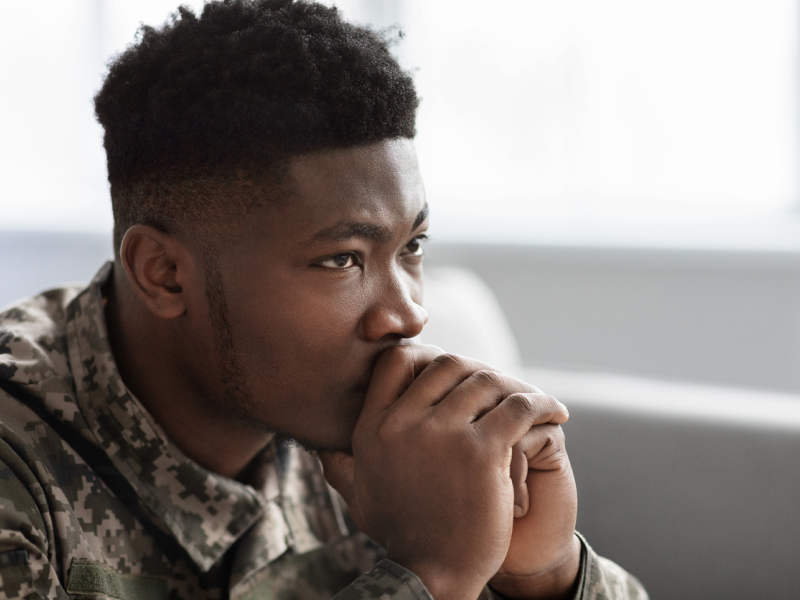
Table of Contents
PTSD Treatment for Veterans: What Works?

Written By: Dr. Rasna Kaur Neelam

Clinically Reviewed By: Dr. Don Gasparini
August 12, 2023
10 min.
Post traumatic stress disorder is a debilitating mental health illness that impacts a high number of veterans. In this article we review PTSD and discuss treatments.
Learn more about our Clinical Review Process
Table of Contents
Post-traumatic stress disorder (PTSD), is a mental health condition that can begin after a person witnesses or experiences a traumatic event. Many kinds of traumatic events can cause PTSD, including natural disasters, sexual assault, car accidents, serious injuries, unhealthy relationships, and more.
Although PTSD can affect anyone (an estimated 1 in 11 people will be diagnosed with PTSD in their lifetime), the problem is especially problematic in war veterans and has likely affected individuals involved in warfare for as long as warfare has existed. In this article, we will focus on PTSD in veterans who have experienced military-related trauma. We will discuss treatment options for veterans suffering from PTSD and review the signs and symptoms of PTSD in veterans.
What therapies exist for PTSD in veterans?
Several therapies have been studied and utilized specifically for treating PTSD—all of which may benefit veterans with PTSD. In this section, we will describe how four of these therapies can be used to treat veterans with PTSD: cognitive behavioral therapy (CBT), prolonged exposure therapy (PE), eye movement desensitization and reprocessing (EMDR), and reconsolidation of traumatic memories (RTM). If you are a veteran with PTSD, one of these therapies may be able to help you.
Cognitive behavioral therapy (CBT)
CBT is used for many mental health conditions, including PTSD. In this form of therapy, clinicians meet weekly in one-on-one sessions with clients to discuss how thoughts, emotions, and actions are connected.
In sessions, clinicians can help identify unhelpful patterns of thinking, called distortions, and work to help reduce negative thoughts. Clinicians can help educate clients on trauma, work on developing positive coping skills, and plan in case of a crisis. CBT may also involve elements of exposure therapy (more on that right below), which can benefit veterans with PTSD when done in a controlled and collaborative way with the client’s consent.

We know military service can be isolating.
That’s why we personalize virtual mental health treatment programs for veterans, active duty member, and their families who are struggling.
Prolonged exposure (PE)
Many veterans will do anything to avoid facing a reminder of the traumatic experience they witnessed or experienced. However, avoiding these traumatic experiences reinforces fear. By contrast, veterans can face their fears in PE and learn to calm their body and mind when reminded of past traumas—which may seem or feel dangerous but actually are not.
PE usually takes place during individual therapy sessions over the course of three months. After establishing trust with the clinician, a veteran will begin with imagined exposure. In these sessions, the veteran will describe the trauma they endured in detail. The clinician will guide them through their thoughts and feelings during this imagined experience.
Over time, when the veteran is ready, they may be assigned “homework” that involves confronting real fears that exist in their everyday life. This may include confronting specific places or people that are connected to the trauma. By gradually increasing exposure to the traumatic incident, and working on coping skills throughout, PE helps veterans process their emotions and overcome fear.
Eye movement desensitization and reprocessing (EMDR)
Many trauma therapies focus on discussing thought patterns and emotions resulting from trauma. In EMDR, however, the focus is on the processing of the traumatic memory itself. The belief behind this type of therapy, called Adaptive Information Processing (AIP), is that traumatic memories causing symptoms of PTSD are not adequately stored and processed. The unprocessed memory may contain emotions, thoughts, beliefs, and physical sensations. When the memory is triggered, these disturbing elements cause symptoms of PTSD. Therefore, these symptoms can be alleviated by processing the traumatic memory “correctly” or in a safer way.
What does EMDR look like in practice with veterans? A veteran meets with a clinician once or twice weekly for a total of 6 to 12 sessions. This form of therapy starts with an introduction, history taking, and preparation. Then, clinicians help the veteran describe and recount the memory of the traumatic event while engaging in guided eye movements or other bilateral stimulation movements like taps. By simultaneously recounting the memory and engaging in bodily movements, the hope is that the vividness of the emotion and memory lessen. Discussing new, positive feelings, self-observation, and re-evaluation then help the client and clinician work toward the next session.
Reconsolidation of traumatic memories (RTM)
RTM is an emerging form of therapy recently studied in male veterans with PTSD. After three, 2-hour sessions of RTM, over 50% of patients in the study no longer met the criteria for PTSD.
The goal of RTM is to reprogram the brain so that it no longer experiences symptoms from traumatic events. The clinician guides the veteran to visualize the traumatic event as if they are watching a black-and-white movie. By doing this, the veteran can learn to separate traumatic memories from traumatic feelings. Because this is an emerging form of treatment, it may be more difficult to find a trained RTM clinician as compared to some of the other forms of therapy listed above.
Please note that the list above is not comprehensive. Several other forms of therapy have been used to treat PTSD—like narrative exposure therapy, brainspotting, mindfulness-based approaches, and brief eclectic psychotherapy. Additionally, some people may benefit from using multiple kinds of therapy.
What medications exist for PTSD in veterans?
In combination with therapy, a physician may prescribe medication to help veterans suffering from PTSD. These medications often are antidepressant pills within a class of medications called selective serotonin reuptake inhibitors (SSRIs) or serotonin-norepinephrine reuptake inhibitors (SNRIs). SSRIs and SNRIs are commonly used to treat PTSD in veterans and non-veterans and can help with depression, anxiety, sleep, and more. Other medications, such as antipsychotics, can also be used in specific cases to treat veterans with PTSD. Because each medication has risks and benefits, it is important to discuss the initiation of all medications with a doctor.
Psychedelics can also be used in the treatment of PTSD for veterans and non-veterans. In a recent phase 3 clinical trial, short-term use of MDMA (the drug commonly known as ecstasy) has shown promising effects in the treatment of PTSD, especially in combination with therapy. This may be because psychedelics like MDMA act on the part of the brain that processes fear and could help it untangle and consolidate traumatic engrained memories.
In the research study, 90 participants were given 80-100 milligrams of MDMA pills before psychotherapy sessions. The study lasted 3 months and included 3 sessions. Results from the study showed that participants who took MDMA were more likely to recover than those receiving placebo. More information is needed, however, before this treatment is fully understood and then legalized.
SSRIs & SNRIs
Antipsychotics
Psychedelics
Antidepressant medication commonly used to treat PTSD in veterans, helping with depression, anxiety, and sleep.
This medication may be used in specific cases to treat veterans with PTSD.
Treatments such as MDMA (“ecstacy”) have shown promising effects in addressing PTSD in veterans, especially in combination with therapy, by acting on the brain’s fear-processing center to untangle and consolidate traumatic memories.
The historic link between PTSD and veterans
PTSD has long been linked with veterans. In fact, before the term PTSD was coined, the diagnosis was called several different military-related names. During the Civil War, it was called irritable heart and Da Costa’s Syndrome; in World War I and World War II, it was shell shock and battle fatigue, respectively; after the war in Vietnam, it was called post-Vietnam syndrome. In 1980, this collection of symptoms noted repeatedly in veterans was finally formally named PTSD in the third edition of the Diagnostic and Statistical Manual of Mental Disorders, a reference book used by psychiatrists and behavioral health clinicians.
Why is PTSD so prevalent in veterans?
Recent veterans are at a higher risk of suffering from PTSD than the general population, with studies pointing to prevalence rates anywhere from 13.5% to 20 or 30%. Why is this the case? Trauma, barriers to care, and stigma all play a role in the high incidence of PTSD and the low numbers of veterans with PTSD seeking care.
- Trauma: The sheer amount of violent and psychological trauma witnessed and experienced by military personnel put veterans at a higher risk for developing PTSD.
- Barriers to care: Veterans face several barriers to care when returning home and seeking mental healthcare. To access Veteran Affairs (VA) services, for instance, an individual must have either an honorable or general discharge. To complicate matters further, long wait lines and a shortage of clinicians experienced in PTSD treatment may discourage veterans from pursuing care even when they have the option.
- Stigma: Just like in the general population, military veterans face stigma surrounding a diagnosis or even experience some of the symptoms of PTSD.
How does PTSD present in veterans?
People with PTSD can experience different signs and symptoms, including veterans. Here are some common ways that PTSD presents in veterans:
Intrusive thoughts
People with PTSD may have intrusive thoughts that they can’t shake or ignore. These may appear as nightmares, recurrent memories, or flashbacks. A veteran, for example, may have a recurrent nightmare where she relives the moment she witnessed a friend severely injured in combat.
Avoidant behavior
Because PTSD can cause negative thoughts and feelings, people with PTSD may do everything in their power to avoid reminding themselves of the traumatic incident they faced. This might mean avoiding certain locations, people, sounds, or situations. It may also mean trying to even avoid remembering the event, talking about it, or acknowledging negative feelings surrounding the event. A veteran with PTSD might avoid meeting up with friends or acquaintances he made in the military because it makes him think too much about a traumatic incident that he experienced and leads to distressing symptoms.
Changes in mood or thinking
As a result of PTSD, people may have trouble remembering details of the traumatic event they witnessed or experienced. Additionally, many people with PTSD experience mistrust, anxiety, and symptoms of depression. An individual recently discharged from the military with PTSD, for example, may find themselves withdrawing from others, feeling depressed, and losing interest in things they once enjoyed.
Increased arousal
In addition to the above, the last classic feature of PTSD is increased arousal. This means that a person feels they are on “high alert” or must be hypervigilant at all times. These individuals can become exhausted because they have a hard time relaxing. A family member who has returned from the military with PTSD, for instance, may be found pacing the hallways at night or easily frightened by the doorbell or other seemingly normal sounds
What are the different types of PTSD seen in veterans?
There are a couple of disorders related to PTSD that can be seen in veterans. One such disorder is acute stress disorder, a briefer mental health condition that can happen within the first month after an individual witnesses or experiences a traumatic event. The major difference between PTSD and acute stress disorder is that PTSD does not resolve within one month, and becomes a chronic condition, whereas acute stress disorder resolves quickly.
As an example, think about a veteran who recently returned from combat overseas. During the first few weeks of her return home, the veteran may experience the sensation of always being on high alert, struggle with anxiety and sleep, and want to avoid talking about their experiences in the military. As the weeks go on, the veteran begins to acclimate to their return home and begin to participate in activities they once enjoyed as the symptoms described above subside.
Another condition related to PTSD is complex post-traumatic stress disorder (C- PTSD)—a diagnosis usually made in people who experience long-term trauma. In addition to the PTSD symptoms described above, people with CPTSD may experience worsened emotional regulation, negative self-perception, preoccupation with the idea of revenge on the perpetrator, negative relationships with others, depression, and more.
As an example, a veteran who was tortured as a prisoner of war for several years may experience C-PTSD. Upon his return home, this person may experience several traumatic flashbacks a day, isolate himself from family and friends, experience serious symptoms of depression and thoughts of self-harm, and be unable to move forward from the trauma that occurred during his time in service.
How can I help a veteran I know suffering from PTSD?
If you or a loved one is a veteran suffering from PTSD, know that you are not alone. Start by destigmatizing the condition within yourself by educating yourself on the signs, symptoms, and treatment of PTSD. Offer support and be patient with your loved one suffering. Look into treatment options that exist in your area that your loved one could utilize. When working with a clinician, ask if they specialize in PTSD and what forms of therapy they can provide. And last but not least, don’t forget to take care of yourself if you are the primary caretaker of someone living with PTSD.
PTSD support for veterans at Charlie Health
Charlie Health is here to support veterans struggling with PTSD. Our virtual intensive outpatient program (IOP) offers more than once-weekly therapy to people dealing with complex mental health challenges, including trauma, PTSD, and C-PTSD. Charlie Health’s team of clinicians is trained in a range of therapies, including exposure therapy and cognitive behavioral therapy, that can benefit veterans facing mental health challenges. Our IOP also offers support groups for family members and loved ones caring for a person dealing with mental health challenges—including veterans struggling with PTSD. Fill out this short form to get started today.




